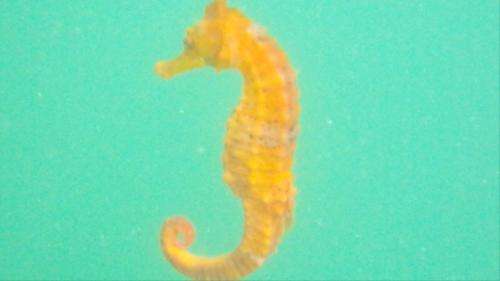World's first video of Hippocampus algiricus, commonly known as the West African seahorse, was captured by Project Seahorse researcher Kate West.
Researchers from the University of British Columbia's Project Seahorse today released the first-ever footage of a little-known seahorse species.
The video, available at projectseahorse.org/footage was filmed off the coast of Senegal and shows a West African seahorse being caught and released by local fishers. The animal swims away, unharmed.
The footage was taken as part of a joint investigation between Project Seahorse, Imperial College London, and the Zoological Society of London (ZSL) into West Africa's burgeoning seahorse trade. Kate West, a graduate student at Imperial and a researcher with Project Seahorse, was travelling on a local fishing boat off the Atlantic coast when she spotted several seahorses being pulled up in a trap.
View other videos from the Kate West's encounter with the West African seahorse at www.projectseahorse.org/footage .
"The fishers caught two animals, and one of them I didn't recognize at first," says West. "After examining them, I convinced the fishers to release the seahorses back into the wild—normally they would be sold." West followed the seahorse with an underwater camera and captured the rare footage released today.
Further study confirmed the species as Hippocampus algiricus, commonly known as the West African seahorse.
"The West African seahorse is one of two native species caught locally for export around the world," says West. "Essentially no research has been done on this species, and nothing is known about its habitat, life cycle, or numbers."
Project Seahorse research to date indicates that the number of West African seahorses in trade has risen dramatically over the past few years, to exports of about 600,000 seahorses annually. They are used primarily in traditional medicines.
"In recent years, the West African seahorse has become highly sought, along with many other seahorse species," says Amanda Vincent, director of Project Seahorse and an associate professor at UBC. "Our fieldwork – the first-ever study of this species – is revealing the fishing and trade pressures they face. We will share our findings with the Senegalese and other governments so they can meet their CITES obligations and make sure their seahorse populations can be sustained."
About the West African seahorse and UBC-ZSL-Imperial College research project:
- The West African seahorse is found primarily along West Africa's Atlantic coast and the Gulf of Guinea, from Senegal to Cote d'Ivoire. Sightings have been confirmed as far south as Democratic Republic of Congo and Angola.
- The maximum recorded adult height of the species is 19 cm. Virtually nothing is currently known about its habitat and life history.
- The West African seahorse is thought to be a vulnerable species, but its true numbers are currently unknown. It is listed as "Data Deficient" on the IUCN Red List of Threatened Species.
- The joint UBC-ZSL-Imperial College London research will continue into 2013.
- Chris Ransom, West and North Africa Programme Manager at ZSL: "Importantly, our findings will be shared with the Senegalese and other governments so they can meet their CITES obligations to ensure that the seahorse trade is sustainable. Together we will help seahorse populations to thrive."
- For more information on the species, visit www.projectseahorse.org.
Provided by University of British Columbia






















